Sometime
in the dim past, a number of neolithic villages grew large enough to
qualify as the first true towns. Traces of such ancient towns
have been found throughout the entire Near East (such as Jericho in
modern Israel/Palestine).
But the earliest true cities, complete with an urban culture or
‘civilization’ (from the Latin, civus, meaning ‘city’), entered history
around 3000 BC along the two major river systems of the middle
East: 1) the lower reaches of the Nile in Egypt and 2) the lower
reaches of the Tigris and Euphrates rivers in what was anciently called
"Mesopotamia" by the Greeks (modern Iraq).
Because of the steady source of the all-important combination of water
and sun, these settlements in Mesopotamia and Egypt flourished easily –
when they were not under attack. As the populations grew, social
organization became more important in sustaining these larger
settlements. The marshy deltas could support large populations –
provided that channels were cut, dikes were built and the marshes were
drained. Further upriver, reservoirs had to be dug to provide a
continuing water source during the dry season.
To protect this investment in real estate, fortified towns had to be
built where the people could take refuge when their lands came under
attack. Men had to be trained as soldiers to oversee the defenses
of the land. And those with special spiritual skills had to be
trained as spiritual specialists (priests), dedicated to the task of
making sure that the gods and goddesses of the land were favorably
disposed to the community's earthly endeavors. Sacrifices would
need to be carefully offered to these gods in order to appease them and
gain their heavenly support.
All this required very complex social coordination – and highly skilled political leadership.
The hierarchical principle
Hierarchy. And into this latter role stepped powerful
personalities – priest-kings who could command the respect of the
populace. At first these priest-kings may have been tribal
elders, leading kinsmen who demonstrated special administrative,
martial and spiritual talents that distinguished them from the
others. This would have been in keeping with neolithic logic.
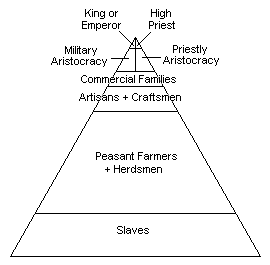 But
eventually a new principle of social organization came to the fore
within these urban settlements, replacing the neolithic principle of
tribal kinship. This new principle is normally termed
‘hierarchy’ – a Greek term which originally applied only to a
well organized political network which governed a community of priests
(Greek: hieros, meaning ‘priest’). A hierarchy is notable by the
way it is organized in a pyramid fashion, with layers of membership
more numerous at the bottom of the pyramid, the lower orders totally
subordinate to the order immediately above them, the members smaller in
number but greater in authority as you move up the network. It is
basically a command system, mechanically efficient though relatively
impersonal – especially compared to the neolithic tribal idea of
interpersonal relations. But
eventually a new principle of social organization came to the fore
within these urban settlements, replacing the neolithic principle of
tribal kinship. This new principle is normally termed
‘hierarchy’ – a Greek term which originally applied only to a
well organized political network which governed a community of priests
(Greek: hieros, meaning ‘priest’). A hierarchy is notable by the
way it is organized in a pyramid fashion, with layers of membership
more numerous at the bottom of the pyramid, the lower orders totally
subordinate to the order immediately above them, the members smaller in
number but greater in authority as you move up the network. It is
basically a command system, mechanically efficient though relatively
impersonal – especially compared to the neolithic tribal idea of
interpersonal relations.
The most notable feature of this emerging hierarchical society is that
it was so huge that what held it together was no longer blood relations
that linked personally every member of the community. The
multitudes who made up these new huge hierarchical societies were from
many different tribes and nations. There was in fact no limit to
the numbers of different tribes and the varieties of national or ethnic
groupings that could be included in these communities. That is
because what held it together was not the social unity of the
multitudes making up the whole population, but the unity or
cohesiveness of the small group at the very top of the social
pyramid. This small group of elite were the ones responsible –
solely responsible – for maintaining the unity and integrity of the
entire social order.
The principle of serfdom or slavery.
How did this hierarchical system come about? How did it get past
the neolithic idea that society must rest only on blood ties? We
can only speculate. Perhaps it involved the insight among some of the
conquering tribes who periodically overran these river settlements that
it was foolish to put to the sword the entire population that they had
just conquered. The conquerors themselves may have had little
interest in farming the land they had just conquered. They
probably preferred to remain warriors – and let the conquered
population remain in place to raise the crops for them as slaves or
serfs. As long as the warriors alone possessed military power the
class of farmer-slaves posed no threat but instead an enormous economic
advantage – much like having large herds of animals.
While this may not have served the enserfed or enslaved farmers' sense
of dignity – it was better than being slaughtered off. In fact it
offered them a greater degree of protection, a greater degree of
security for the farmer to do his work unmolested under these
newcircumstances – for their warrior-conquerors were better able to
protect the lands than the farmers themselves.
Or – perhaps this social order simply evolved over time as a tribe
proved so successful in managing the water resources around it that the
population simply grew to monumental proportions – and one or another
clan within the tribe grew to possess the larger responsibility of
overseeing the work – until it came to constitute itself as a ruling
class. Perhaps also the usefulness of allowing unrelated tribes
to take shelter within the precincts of the growing community came to
be valued for the labor that this offered, though these immigrants
would find themselves in the community with a servant-worker status –
or even into serf or slave status, as generation after generation
became bound to the soil and the lords of the land who presided over
them. This is what seems to have happened to the Israelites or
Hebrews who took refuge in Egypt during a long drought – and eventually
became bound servants or slaves to the Egyptians.
Or perhaps it was some combination of conquest and slow development
that produced this massive hierarchical structure. But what is
certain is that around 3000 BC these huge communities began to dominate
the political scenes in Egypt and Iraq – and (perhaps that early) also
along the Indus River in Pakistan. China developed similar
systems along the Huang He (Yellow) and the Chang Jiang (Yangtze)
rivers – though centuries later than those of the Middle East.
The ruling class or caste and the priest-king or priest-emperor.
The cohesion of this whole system depended heavily on the unity and
power of the ruling class – and the particular abilities of the head of
this ruling class. At this upper level the society worked much
more like a tribal unit, in that the members of the ruling class tended
to come from a exclusive order perhaps indeed derived from a single
ancient blood line. Those born into the society of the ruling
class were the only ones entitled to the privileges of rulership.
The whole society was ultimately theirs – which they were well aware
of. But it was also their sole responsibility, this enormous
social order they had created or inherited.
At the head of this ruling class was typically a person of enormous
political and religious stature. It was not uncommon to believe
that he (or she) came from a special line of ancestors who may actually
have included one of the gods himself or herself. Thus this
individual was normally considered semi-divine, if not something of a
living god himself. Certainly this was the image projected by the
Egyptian Pharaohs. The Macedonian-Greek adventurer Alexander made
such a claim for himself. Even some of the Roman emperors
attempted to make such claims of divinity.
The Law
Over time, the power of the ruling classes was systematized through the
power of law. Legal covenants and rules of behavior
(usually given and enforced by some presiding god) now bound the rulers
and the ruled into some kind of orderly accommodation. Law proved
to be as capable as blood and custom in uniting people into effective
social units. Indeed, most highly esteemed among the rulers by
even the ruled were those ‘law-givers’ who proved able to enforce the
rule of law – and thus protect the peace – within these vast domains.
On the many carved stone (steles) located around the ancient kingdom of
Hammurabi of Babylon are found not only engraved copies of his great
Law (ca. the late 1700s BC), but usually at the top of each of these
steles is a bas-relief carving showing Hammurabi receiving these laws
from the hand of the Babylonian sun god (presumably Shamash).
This image gave huge weight to his laws, not just because they were
fair and thus worthy of being respected, but because they had the
weight of a great god behind them.
The urban center: the "city" part of civilization
The city. From a
purely material point of view, the most notable feature of civilized
society was the central role played by the city. The city was the
one place where no agriculture took place. Instead the city was
devoted to social pursuits other than farming. The city might
have been a garrison town where soldiers were housed. Or it might
have been a religious site devoted to the worship of one or another
god. It might have been the residence of the ruling
classes. It might have been a commercial center where artisans
and craftsmen gathered to manufacture and sell their wares. But
most likely it was a place where several or even all of these
activities occurred together.
Probably the heart of the city was its worship center – containing a
temple or temples housing the priests and some representational form or
other (perhaps a statue) of the god or gods they served. The
usual order of the day was receiving the sacrifices of meat or grain
brought by the pilgrim – part burned before the altar for the benefit
of the god and part set aside for consumption by the priests.
Probably somewhere nearby was the palace or palaces that housed the
civil rulers – and that opened their doors upon occasion for these
rulers to hear appeals for justice from the citizenry. And
probably nearby was the market place where pilgrims could trade some of
the extra wealth that they brought with them for just this
purpose. The market stalls with their goods on display looked out
on the main street or passageway, while behind the market stalls were
the work shops where workers toiled to produce the goods to be sold or
traded. Nearby cafes, restaurants, and hostels or hotels offered
refreshment and rest for the urban visitor – as well as a place for the
locals to take moments to relax. And of course there were homes
for those who made the city their permanent place of residence: the
aristocracy in their grand homes (probably in the neighborhood of the
palace and temple), the prosperous merchants in their private homes,
and the artisans and craftsmen – in rooms frequently in the floor above
their shops.
The city was always a buzz of activity – but especially during the high
holy seasons when important traditional festivals drew in people from
all around the realm. The cities would be decorated for the event
and parades with priests and civil notables, musicians and dancers,
masses of costumed participants, would snake through the city’s crowded
streets toward the temple where the final acts in the festival would
take place. Business would be very good. Drunken or at
least tipsy revelry would be commonplace – and so would be pickpockets
and con artists who took advantage of the frolicsome disorder.
All in a week’s fun!
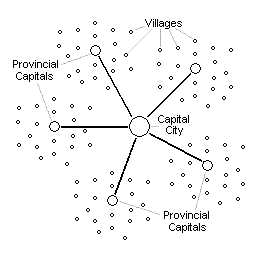 The urban-rural network.
The city was the heart of a very much larger realm of city-state,
kingdom or empire. Urban life could not exist if it were not
vitally connected to the rural countryside of villages and fields where
the food supporting the whole society was produced. To support the
non-farming culture of the cities there would have to be a huge rural
culture busy at work. For each urban dweller there might have to
be ten to twenty farmers growing food – enough that the farmers could
feed not only themselves and their villages but also produce the excess
amount of food that could – through religious tithes and civil taxes –
support the urban population. The urban-rural network.
The city was the heart of a very much larger realm of city-state,
kingdom or empire. Urban life could not exist if it were not
vitally connected to the rural countryside of villages and fields where
the food supporting the whole society was produced. To support the
non-farming culture of the cities there would have to be a huge rural
culture busy at work. For each urban dweller there might have to
be ten to twenty farmers growing food – enough that the farmers could
feed not only themselves and their villages but also produce the excess
amount of food that could – through religious tithes and civil taxes –
support the urban population.
The urban-rural network could be very complex and very extensive.
A grand imperial city may have had very little or only occasional
direct contact with the rural world around it – but instead found its
life-support through lesser cities – provincial capitals actually
– that passed on to the imperial capital a part of the rural revenue
that they gathered. In this case it would be the provincial
capitals that networked directly through trade and taxes with the rural
tribal villages – and with the nomadic herdsmen who would occasionally
pitch their tents just outside these provincial cities in order to
trade meat for manufactured goods.
City-states, kingdoms and empires
With the appearance of this new principle of social organization – the
possibilities of vast and complex community life or ‘civilization’
emerged. Towns could become cities – connected economically to a
vast hinterland of small towns and rural villages. People no
longer had to be related by ‘blood-lines’ in order to cooperate
socially. Freed from the restrictions of kinship organization,
these communities could incorporate thousands, even tens and hundreds
of thousands of people into a single political unit. Thus
cities could become the centers of grand city-states, or kingdoms which
united several or more city-states, and empires which united a number
of kingdoms. The possibilities for territorial expansion were
enormous once the idea of hierarchical order was accepted.
|


 But
eventually a new principle of social organization came to the fore
within these urban settlements, replacing the neolithic principle of
tribal kinship. This new principle is normally termed
‘hierarchy’ – a Greek term which originally applied only to a
well organized political network which governed a community of priests
(Greek: hieros, meaning ‘priest’). A hierarchy is notable by the
way it is organized in a pyramid fashion, with layers of membership
more numerous at the bottom of the pyramid, the lower orders totally
subordinate to the order immediately above them, the members smaller in
number but greater in authority as you move up the network. It is
basically a command system, mechanically efficient though relatively
impersonal – especially compared to the neolithic tribal idea of
interpersonal relations.
But
eventually a new principle of social organization came to the fore
within these urban settlements, replacing the neolithic principle of
tribal kinship. This new principle is normally termed
‘hierarchy’ – a Greek term which originally applied only to a
well organized political network which governed a community of priests
(Greek: hieros, meaning ‘priest’). A hierarchy is notable by the
way it is organized in a pyramid fashion, with layers of membership
more numerous at the bottom of the pyramid, the lower orders totally
subordinate to the order immediately above them, the members smaller in
number but greater in authority as you move up the network. It is
basically a command system, mechanically efficient though relatively
impersonal – especially compared to the neolithic tribal idea of
interpersonal relations.  The urban-rural network.
The city was the heart of a very much larger realm of city-state,
kingdom or empire. Urban life could not exist if it were not
vitally connected to the rural countryside of villages and fields where
the food supporting the whole society was produced. To support the
non-farming culture of the cities there would have to be a huge rural
culture busy at work. For each urban dweller there might have to
be ten to twenty farmers growing food – enough that the farmers could
feed not only themselves and their villages but also produce the excess
amount of food that could – through religious tithes and civil taxes –
support the urban population.
The urban-rural network.
The city was the heart of a very much larger realm of city-state,
kingdom or empire. Urban life could not exist if it were not
vitally connected to the rural countryside of villages and fields where
the food supporting the whole society was produced. To support the
non-farming culture of the cities there would have to be a huge rural
culture busy at work. For each urban dweller there might have to
be ten to twenty farmers growing food – enough that the farmers could
feed not only themselves and their villages but also produce the excess
amount of food that could – through religious tithes and civil taxes –
support the urban population. 


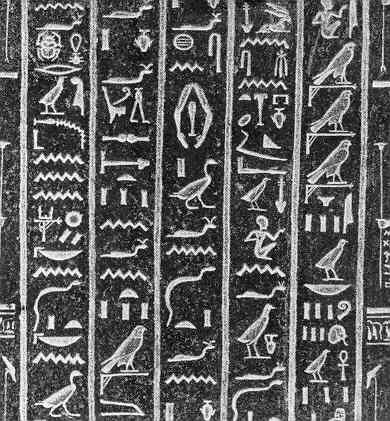
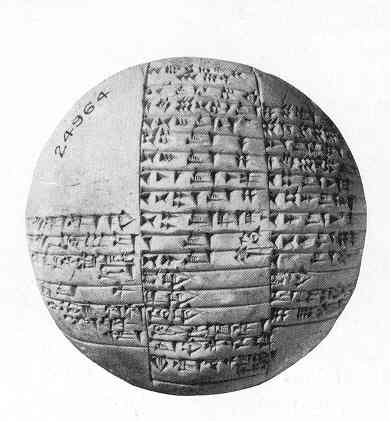
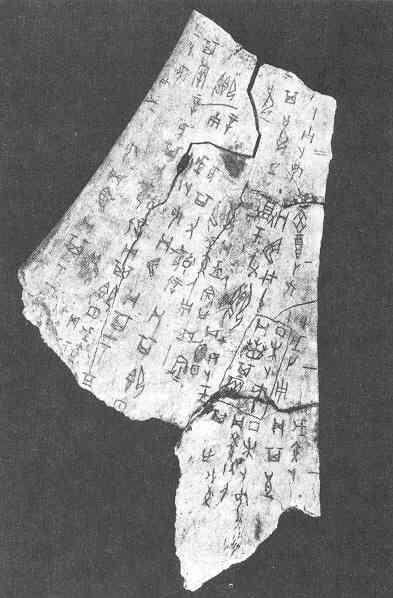



 Miles
H. Hodges
Miles
H. Hodges